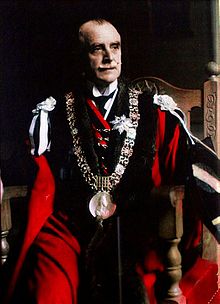Alfie Byrne
| Alfie Byrne | |
|---|---|

Byrne in his mayoral robes
|
|
| Lord Mayor of Dublin | |
|
In office June 1954 – May 1955 |
|
|
In office June 1930 – June 1939 |
|
| Teachta Dála | |
|
In office July 1937 – March 1956 |
|
| Constituency | Dublin North-East |
|
In office February 1932 – July 1937 |
|
|
In office August 1923 – December 1928 |
|
| Constituency | Dublin North |
|
In office June 1922 – August 1923 |
|
| Constituency | Dublin Mid |
| Senator | |
|
In office December 1928 – December 1931 |
|
| Member of Parliament for Dublin Harbour |
|
|
In office October 1915 – December 1918 |
|
| Personal details | |
| Born |
Alfred Byrne 17 March 1882 Dublin, Ireland |
| Died | 13 March 1956 (aged 73) Dublin, Ireland |
| Nationality | Irish |
| Political party | Independent |
| Other political affiliations |
Irish Parliamentary Party |
| Children |
Patrick Byrne Alfred P. Byrne Thomas Byrne |
Alfred "Alfie" Byrne (17 March 1882 – 13 March 1956) was an Irish politician, who served as a Member of Parliament (MP) and as a Teachta Dála (TD). As Lord Mayor of Dublin he was known as the "Shaking Hand of Dublin".
The second of seven children, his childhood home was at 36 Seville Place, a terraced house with five rooms just off Dublin's North Strand. Byrne dropped out of school at the age of 13, and was soon juggling jobs as a grocer’s assistant and a bicycle mechanic. Eventually he used his savings to buy a pub on Talbot Street.
Byrne became an Alderman on Dublin Corporation in 1914. He was a member of the Dublin Port and Docks Board, a significant position for a politician from the Dublin Harbour constituency. In the records of the Oireachtas his occupation is given as company director. He was elected as an MP for Dublin Harbour in a by-election on 1 October 1915 as an Irish Parliamentary Party candidate. and later to Dáil Éireann as an independent in favour of the Anglo-Irish Treaty. Without the benefit of a party machine, he soon realised that attending to constituents' needs was the only sure way to retain his seat. In several elections he secured more votes than any other politician in the country. His personal archive, which is on view in The Little Museum of Dublin, includes many letters from men who thought he could find them a wife.
The 1916 Easter Rising was followed by the rapid decline of the Irish Parliamentary Party and the rise of Sinn Féin, even in the formerly immensely safe Dublin Harbour constituency. At the 1918 general election Byrne was defeated by Sinn Féin candidate Philip Shanahan. Following independence, Byrne was elected as an independent TD for the Dublin Mid constituency at the 1922 general election to the Third Dáil. From 1923 to 1928, he represented Dublin North. He was an elected a member of Seanad Éireann, for a six-year term, in 1928. He vacated his Dáil seat on 4 December 1928. He resigned from the Seanad on 10 December 1931. Byrne returned to the Dáil in 1932 and sat there until his death in 1956. He represented Dublin North (1932–37) and Dublin North-East (1937–56).
...
Wikipedia
